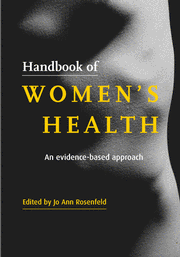Book contents
- Frontmatter
- Contents
- List of contributors
- Common abbreviations used in the text
- Normal blood values in women and during pregnancy
- Introduction
- 1 Singular health care of women
- Preventive care
- 2 Preventive care of adolescents
- 3 Preventive care of adults(19 to 65 years)
- 4 Preventive care for older adults
- 5 Cigarette smoking and cessation
- 6 Nutrition
- 7 Exercise
- Psychosocial health
- Sexuality
- Genitourinary medicine
- Breast disorders
- Psychological disorders
- Common medical problems
- Index
5 - Cigarette smoking and cessation
Published online by Cambridge University Press: 28 October 2009
- Frontmatter
- Contents
- List of contributors
- Common abbreviations used in the text
- Normal blood values in women and during pregnancy
- Introduction
- 1 Singular health care of women
- Preventive care
- 2 Preventive care of adolescents
- 3 Preventive care of adults(19 to 65 years)
- 4 Preventive care for older adults
- 5 Cigarette smoking and cessation
- 6 Nutrition
- 7 Exercise
- Psychosocial health
- Sexuality
- Genitourinary medicine
- Breast disorders
- Psychological disorders
- Common medical problems
- Index
Summary
Cigarette smoking is one of the most modifiable causes of death and disease. Helping smoking cessation is one of the most important messages and actions physicians can perform for their patients. Earlier in this century, women started smoking at older ages and in smaller numbers than men, but now numbers, percentages, years of smoking history, and complications of smoking in women are approaching those of men. In addition, fewer women may be quitting smoking, making the message more critical.
Epidemiology
Twenty-two million adult women in the USA are cigarette smokers and, although more men smoke, the difference in percentages is narrowing. In 1994, 28 percent of men and 23 percent of women considered themselves smokers in the USA.
Twenty-one to 23 percent of women smoked in a large prospective UK heart disease study of more than 12,000 individuals.
Smoking contributes to 17 percent of all women's deaths and significantly to at least one-third of all cancer deaths in the USA (as compared to 45 percent in men). Tobacco-related deaths in women will double in the next 30 years. The cumulative risk of death from lung cancer by age 75 years in the UK in one large case-controlled study rose from 1 percent to 10 percent in female smokers from 1950 to 2000, as compared with a rise from 6 to 16 percent in male smokers. In Denmark where 18 percent of women smoke heavily, the risk of tobacco-related deaths in women increased steadily, from fewer than 1% of all deaths in 1950 to 25 percent in 1990.4
[…]
- Type
- Chapter
- Information
- Handbook of Women's HealthAn Evidence-Based Approach, pp. 72 - 83Publisher: Cambridge University PressPrint publication year: 2001



